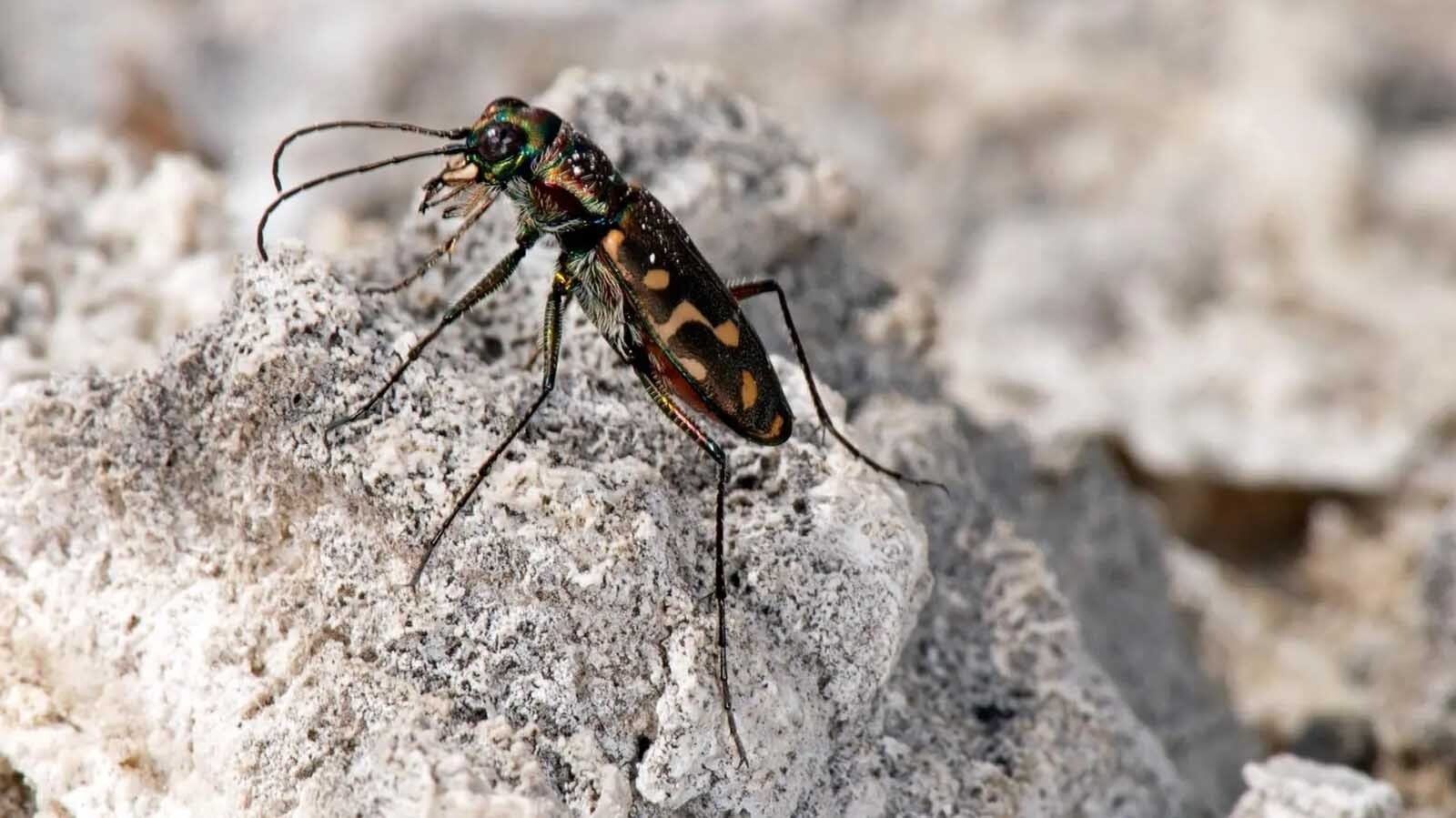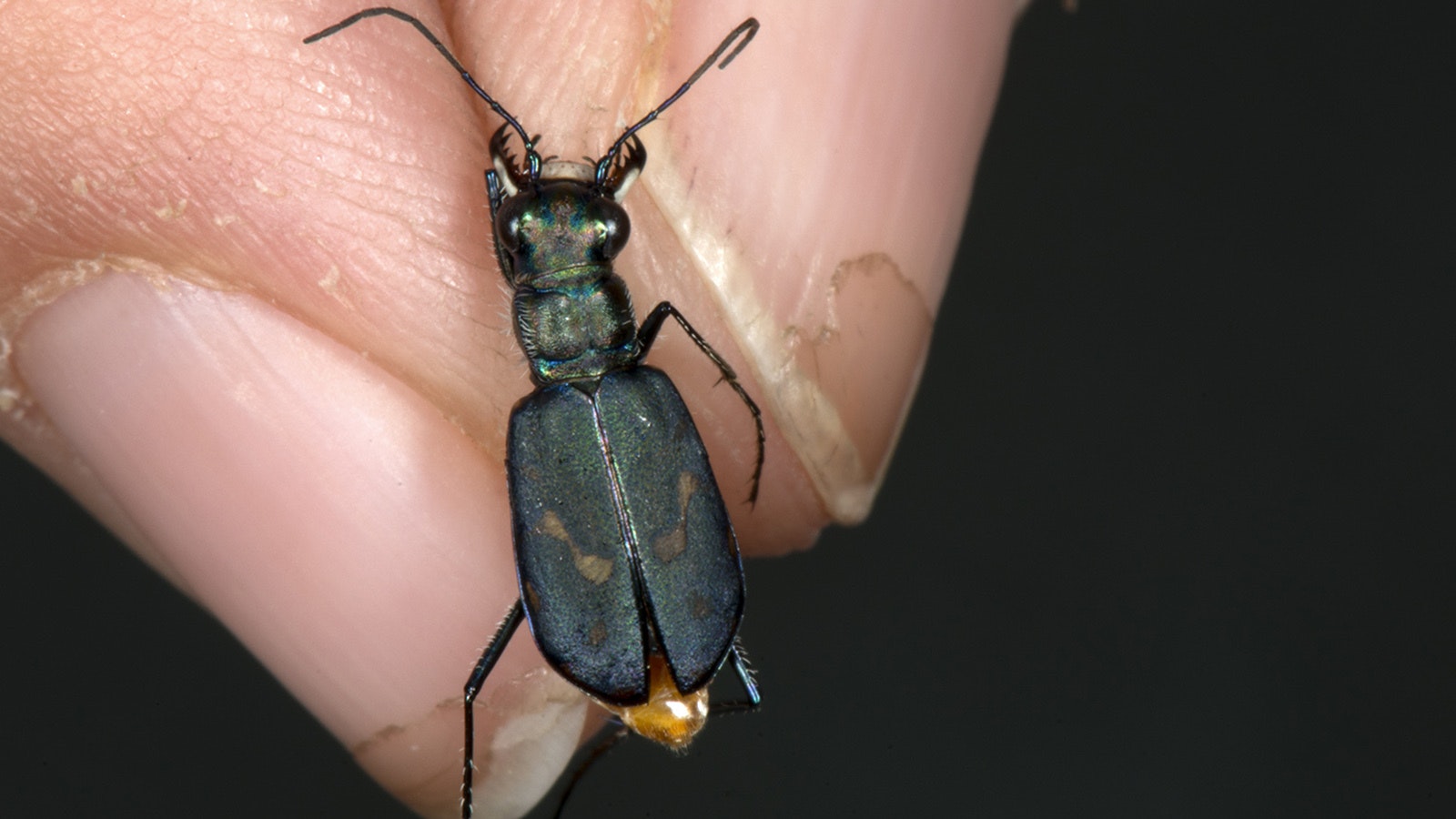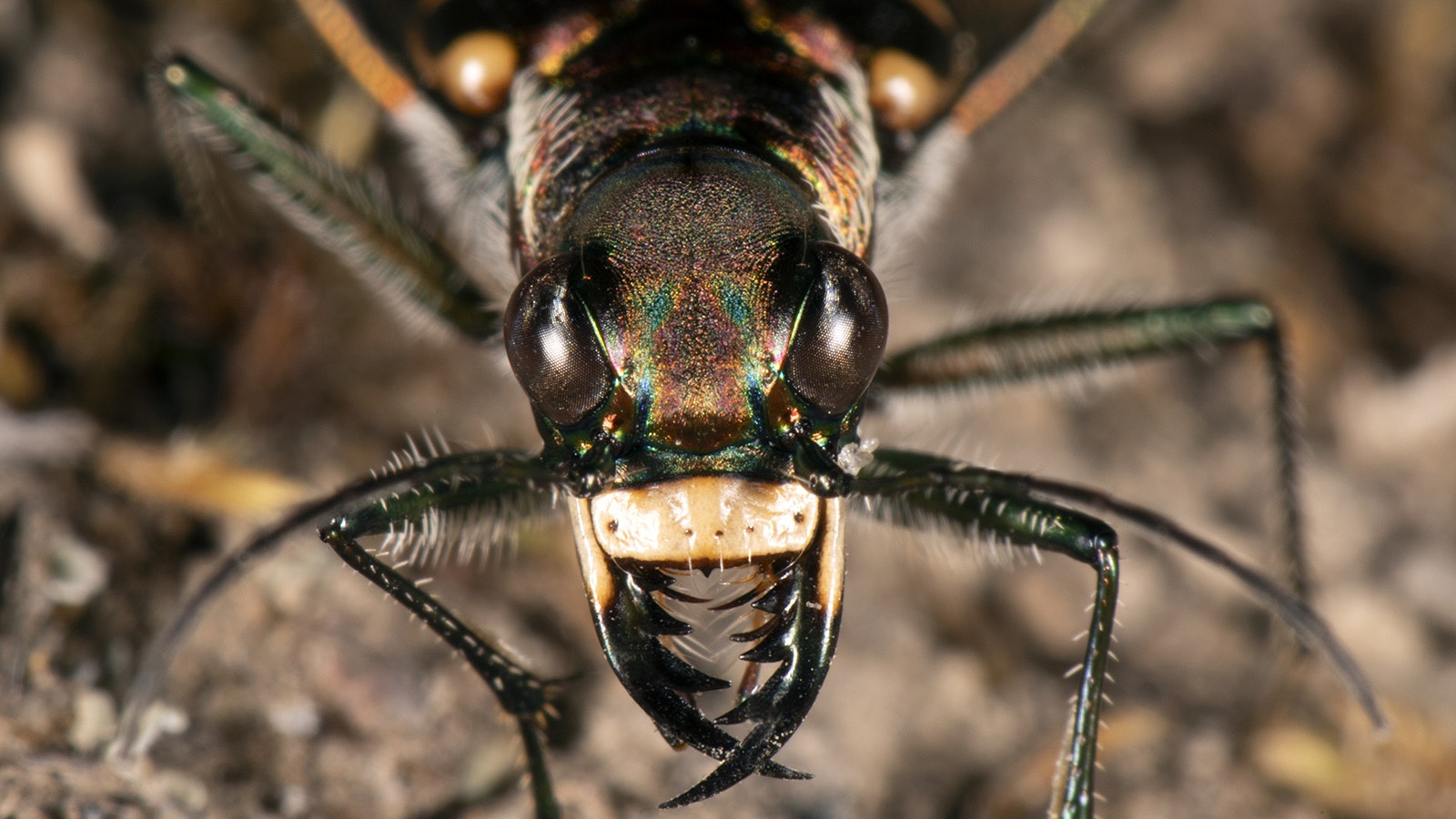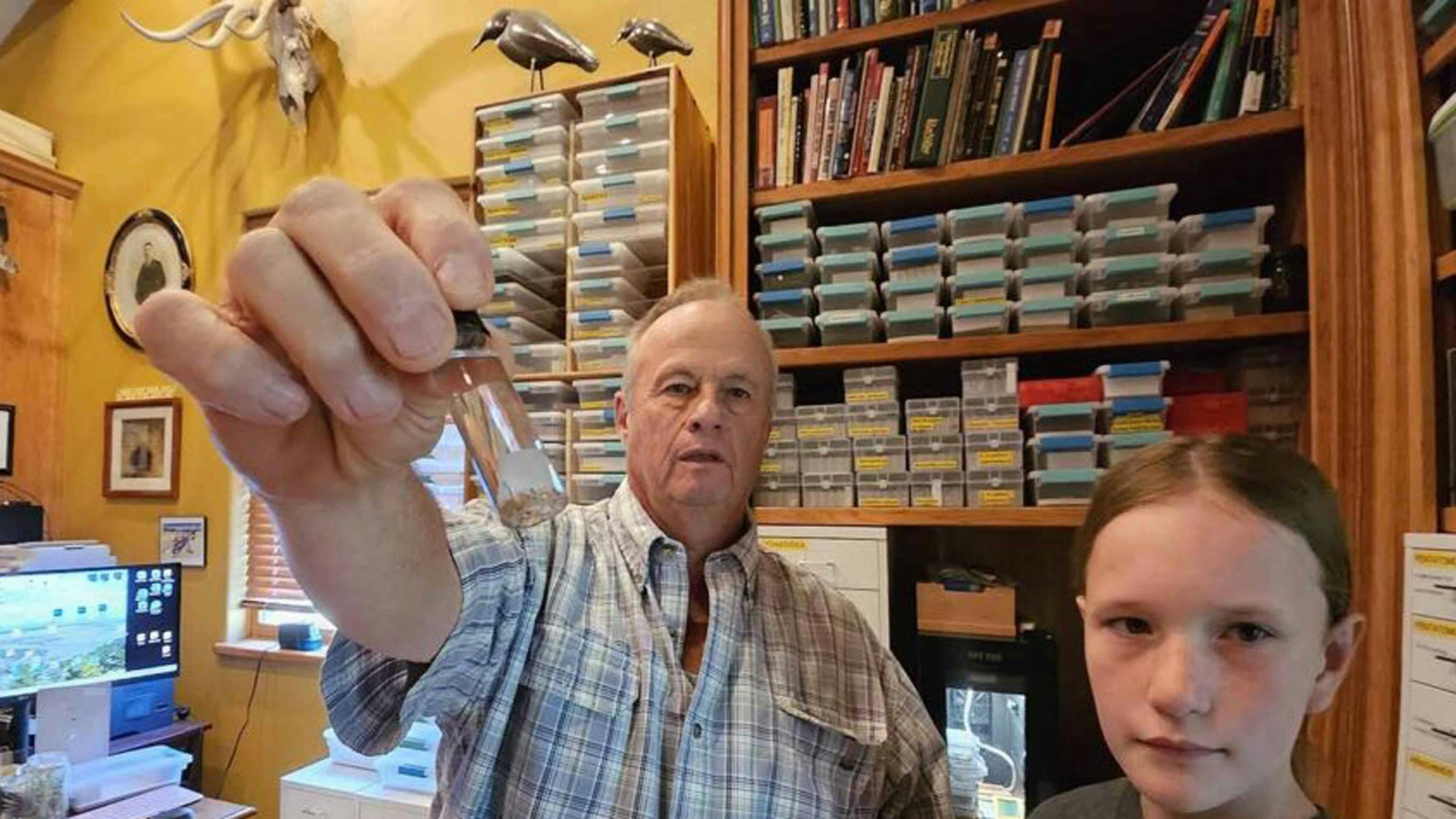Yellowstone National Park is full of grizzlies, wolves and elusive mountain lions. But the apex predators of the park might be those tiny tiger beetles that thrive around thermal pools — and hunt kill everything else.
The wetsalts tiger beetle is one of the most unique and overlooked critters in the Greater Yellowstone Ecosystem, and can really take the heat.
Many people don’t see wetsalts tiger beetles during their Yellowstone visits, as they’re only an inch long and thrive where others fear — and are forbidden — to tread. But for entomologists like Leon Higley and Bob Peterson, they’re one of the most exciting and mysterious examples of adaptability in an already incredible ecosystem.
“The amazing thing about them is that they don’t seem to care about heat,” Higley said. “We’ve studied tiger beetles that run into the shade or do other behaviors during the hottest part of the day. Yellowstone’s tiger beetles don’t do any of that. They’re well-adapted and exclusively adapted to the extreme heat of thermal environments.”
One thing they have in common with other tiger beetles is they’re fearsome predators. They’ll hunt, ambush and eat anything they can catch.

What's Going On With That Beetle?
Higley was visiting Mammoth Hot Springs with his son in 2006 when he took notice of a tiger beetle on one of the thermal pools. Even for someone who’s studied tiger beetles across the United States, he couldn’t understand the lifestyle of this beetle.
“I immediately knew something wasn't right,” he told Cowboy State Daily. “It was just too hot. The beetle shouldn't be able to survive in those temperatures, but there it was. That's what got me interested. What was going on with this beetle?”
Higley, a professor of applied ecology at the University of Nebraska–Lincoln, resolved to unlock the mysteries of Yellowstone’s tiger beetles. It took a team of dedicated entomologists nearly two decades to produce two research papers about these unique populations of “extremophile beetles.”
Peterson, a professor of entomology and head of the Department of Land Resources and Environmental Sciences at Montana State University, was one of those team members. He was also intrigued by the utterly unique aspects of Yellowstone’s tiger beetles.
“Tiger beetles are already warm-adapted,” he said. “They like warm conditions. But Yellowstone’s tiger beetles don’t behave like others outside the park. It’s a truly remarkable population that is behaviorally very different from other tiger beetles.”
Some Like It Hot
There are more than 2,600 species of tiger beetles in the family Cicindelidae. The adults have distinctively large eyes, long, spindly legs and large serrated mandibles.
Tiger beetles undergo significant changes throughout their lifecycles. Even as larvae, they are ambush predators that live in burrows.
“They’re ‘sit-and-wait’ predators,” Higley said. “They wait for food, usually ants, to come within striking distance, then grab and haul them into their burrows.”
Adult tiger beetles hunt very differently, using speed and large mandibles to hunt other insects. They’re among the fastest known insects, with some capable of incredibly fast reflexes and reaching speeds of nearly 6 miles per hour — warp speed for an inch-long insect.
Both Higley and Peterson said that tiger beetles are highly adaptable, and many are adapted to live in inhospitable climates and environments. Many species have evolved to thrive in the heat, but that doesn’t mean they’re immune to it.
“Many tiger beetles will run into the shade, dip their abdomens in water or use their legs to raise their bodies above the ground, called stilting, to regulate their temperature,” Higley said. “But Yellowstone’s tiger beetles don’t do that.”
From the beginning of their research, Higley and Peterson knew that Yellowstone’s tiger beetles were “highly adapted” to thermal pools and basins. But these beetles were adapted to extreme temperatures in exclusive locations.
“You won't find the beetles anywhere where there aren't thermal features,” Peterson said. “There are salt flats along the Snake River in Idaho where you find tiger beetles, but you won’t find beetles in the salt flats in Yellowstone, probably because it’s too cool.
“These beetles have been selected to thrive in that extreme warmth. That’s what’s cool about them — they like the warmth.”
Survival In Scalding Steam
Wetsalts tiger beetles are the apex predators of a small-but-important invertebrate ecosystem in Yellowstone’s thermal basins. Peterson said the beetles feed on unique thermophilic insect species.
“There are other insects adapted to live in that environment,” he said. “There’s a thermophilic species of brine flies that live in Yellowstone. They feed on the algal and bacterial mats, while the tiger beetles feed on them. It’s a big part of their diet.”
Higley said tiger beetles also feed on insects that aren’t adapted to their extreme habitat. Anything that succumbs to the steam, caustic water and boiling temperatures is easy pickings for the beetles.
“It’s like a home delivery system,” he said. “They don’t necessarily have to go out hunting. They can wait for things to get caught in the water and perish.”
A bison that got caught and died in a 160-degree Yellowstone thermal pool last weekend is a grand feast for wetsalts tiger beetles.
Meanwhile, the beetles are entirely unbothered by their extreme environment. The same thermal pools that can kill bison, elk and humans are prime real estate for tiger beetles.
Even apex predators are susceptible to attack or predation, but Yellowstone’s tiger beetles have an excellent home defense.
Higley said their environment is too dangerous for the few predators they have.
“There are some spiders in those areas,” he said. “And a few birds might snatch one up, but for the most part, they’re protected where they are. They are the tigers of their ecosystem.”
Here, There, Not Everywhere
After years of research, Higley, Peterson and their colleagues identified thriving wetsalts tiger beetle populations at 19 locations in Yellowstone.
“Those are just in the thermal areas we had access to,” Higley said. “My guess is that they’re probably widespread through many areas in the backcountry.”
The tiger beetle team spent most of its time studying the populations at Mammoth Hot Springs and the Norris Geyser Basin. The tiny beetles were meticulously observed, their behaviors documented, and their anatomy scrutinized.
One revelation was that Yellowstone’s tiger beetles have several anatomical adaptations to the extreme heat of the thermal pools, which would explain their lack of temperature regulation behaviors. Higley identified their abdomens as “the most interesting adaptation.”
“The bottom of its abdomen acts like a giant reflector,” he said. “It reflects infrared radiation away from its body so its body doesn't heat up from the water.”
Higley and Peterson expected the tiger beetle larvae to burrow some distance away from the water’s edge. In reality, they’re all about beachfront property.
“We thought the adults would be in the thermal pools and the larvae would burrow a long way away,” Higley said. “To our surprise, the larval burrows are right there around the edges of a lot of the thermal pools.”
According to Higley, this gives the larvae a unique advantage in Yellowstone's ever-changing climate. He believes they have higher winter survival rates than other insects in the Greater Yellowstone Ecosystem because of the “central heating in their burrows.”
Something Higley and Peterson didn’t find were tiger beetles anywhere else in Yellowstone.
While tiger beetles can be found in a wide range of different habitats, Yellowstone’s populations only exist in and around thermal pools.
“We think they have to have soil with the right texture and temperature for their larvae to burrow in,” Peterson said. “They’re everywhere where they have the right habitat, but nowhere else. You won’t find these tiger beetles anywhere else in Yellowstone.”

Just How Different
Many of the greatest scientific discoveries in history have raised more questions than they answered. Higley and Peterson have learned a lot about Yellowstone’s tiger beetles, but their research has further fueled their curiosity.
The biggest question the entomologists want to answer is whether Yellowstone’s tiger beetles are a distinct species or just a highly adapted variant of an existing species.
“How closely related or how much they may vary from other tiger beetles genetically is a real curiosity for us,” Higley said. “That's a question we can't answer yet because we haven’t been able to do the genetics work.”
Tiger beetles are an important, but relatively recent, addition to Yellowstone.
Higley and Peterson believe they’ve only been there for around 14,000 years after the melting of the Pinedale Glacier that covered all of Yellowstone and Grand Teton National Parks during the last Ice Age.
“There were no animals or plants in Yellowstone 17,000 years ago, because it was covered with a mile-high block of ice,” Peterson said. “As it melted, it opened that environment to be repopulated. That’s when the tiger beetles moved in, and they’re already warm-adapted.”
Peterson also added that another mystery to be solved is how Yellowstone’s tiger beetles dispersed throughout the park’s thermal basins, another question that could be answered by genetic research.
“The adults have wings, so they can fly, but not terribly gracefully,” he said. “So, how do they disperse? Are they genetically mixed or genetically isolated? Does a male tiger beetle fly a mile and a half to mate with females in another thermal basin? We don’t know, and we’d love to know.”

Beetle Bioprospecting
Higley and Peterson are thrilled with their discoveries about the wetsalts tiger beetles in the Greater Yellowstone Ecosystem. It’s yet another example of the bounty of scientific research in what Peterson called “the fantastic natural laboratory” that is Yellowstone.
“It’s a very special place to do research,” Peterson said. “Yellowstone and the National Park Service serve many purposes. One of those purposes is to understand more about the world we live in and the other organisms we share a planet with.
“By studying these organisms, like the tiger beetle, we can also discover things that we can use to improve our health and livelihoods.”
Peterson said this in reference to an unexpected outcome from the tiger beetle research. In addition to two published papers on Yellowstone’s tiger beetles, the research team applied for and received a patent based on their highly adapted anatomy.
“There's an interest in what's called ‘bioprospecting’ at Yellowstone, which is looking for biological things that may have application to human problems,” Higley said. “That's definitely the case with the tiger beetles.”
The patent Higley, Peterson, and their peers obtained was based on the microgrooved structure on the tiger beetle’s abdomen, which is used to refract infrared radiation, but also allows their “hydrophobic” exoskeletons to retain a layer of water. The unique structure on their exoskeletons was new to science and could be used for the benefit of humanity.
Patent aside, both entomologists are thrilled that the world now knows more about the unique tiger beetle populations in Yellowstone National Park. Although they’re small and harmless to humans, their presence is a clear sign that they’re enriching their world, and possibly our own.
“Tiger beetles are a generically good indicator of the health of an ecosystem,” Higley said. “Having healthy tiger beetle populations shows that you have a healthy ecosystem. You don't think of something as harsh as a thermal pool as being an ecosystem, but tiger beetles are the apex predators of that ecosystem, and they all seem very healthy and robust.”
Peterson said it’s a great example of the impact of rigorous scientific research. What started as an observation of a small beetle in a hot pool has turned into something that could change lives in the future.
“On the surface, it’s just fundamental biological research,” he said. “You’re learning more about something, but what good is it? And in this case, we’re discovering new things about our planet and information that could help humanity and the human cause — all because this warm-adapted tiger beetle is so cool.”
Andrew Rossi can be reached at arossi@cowboystatedaily.com.





